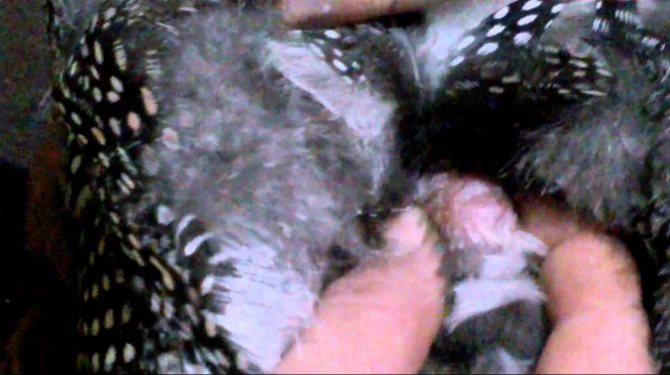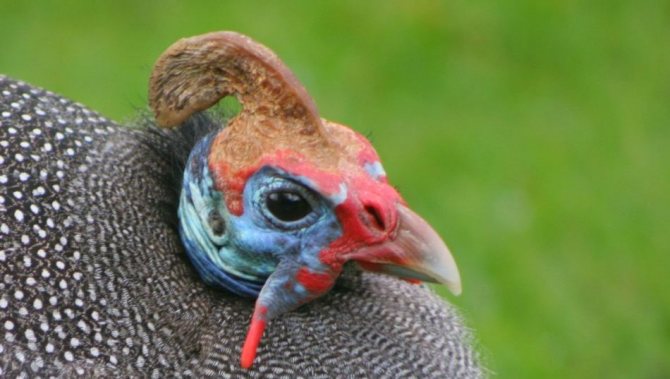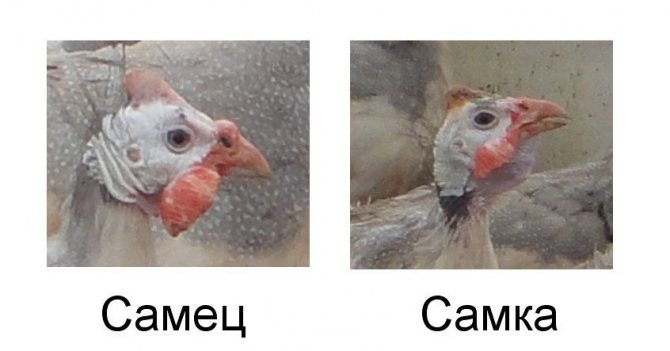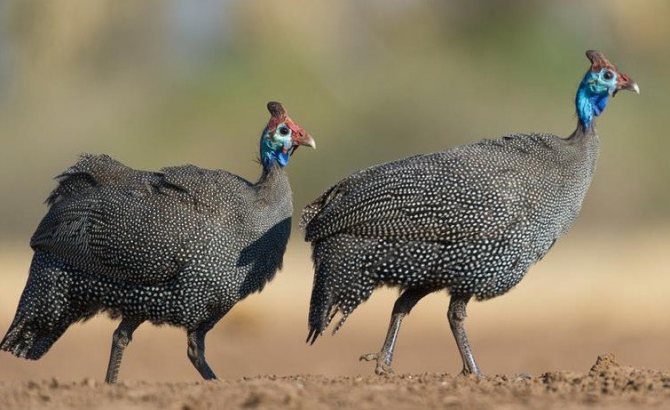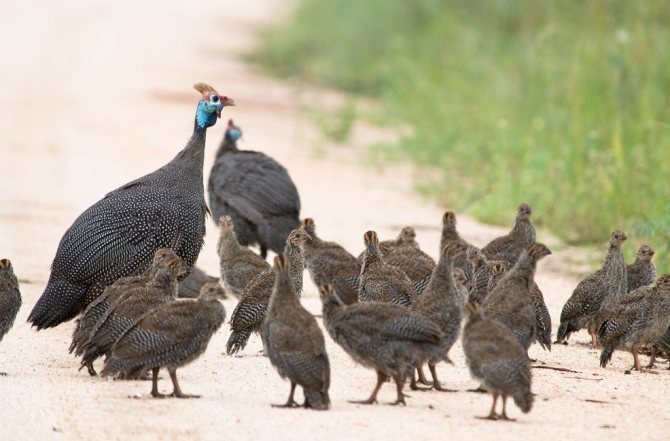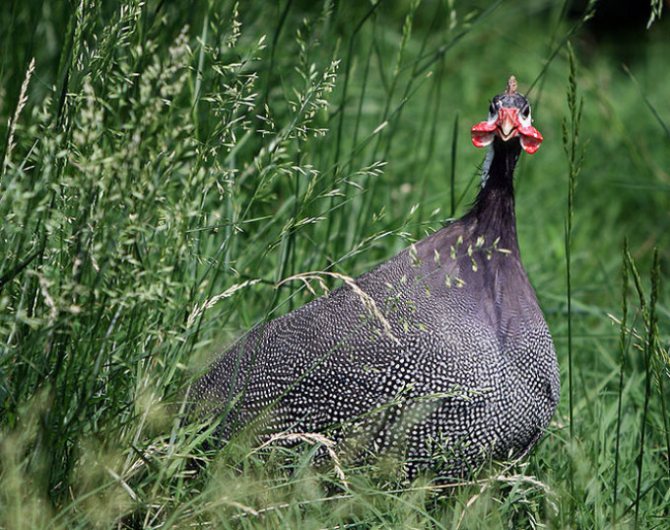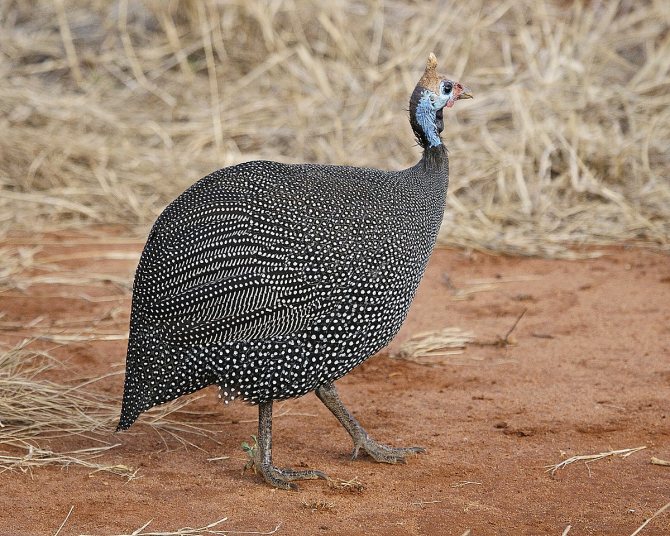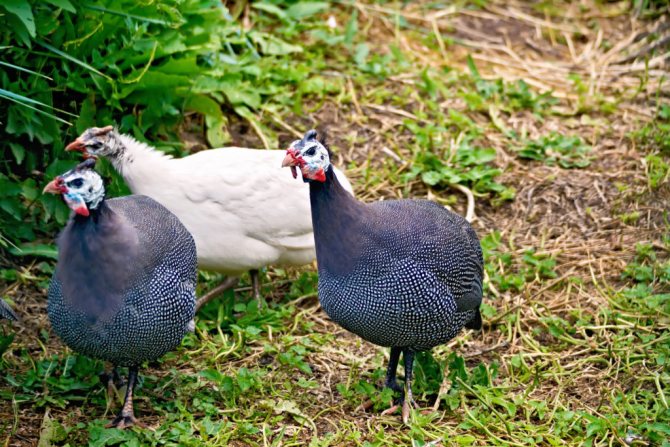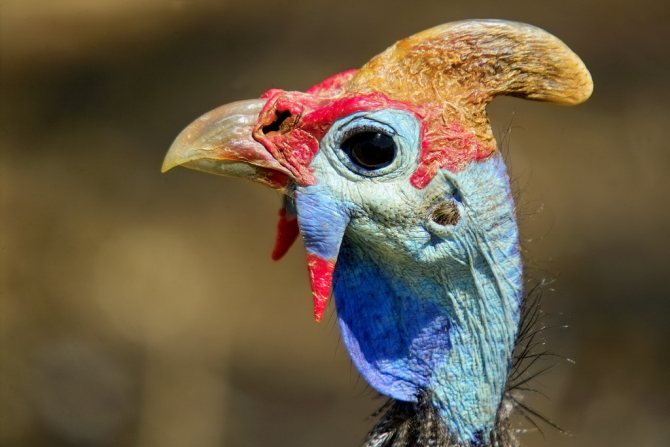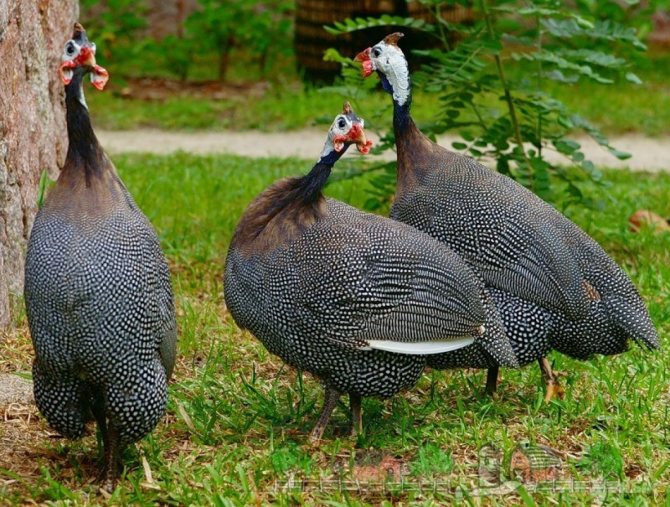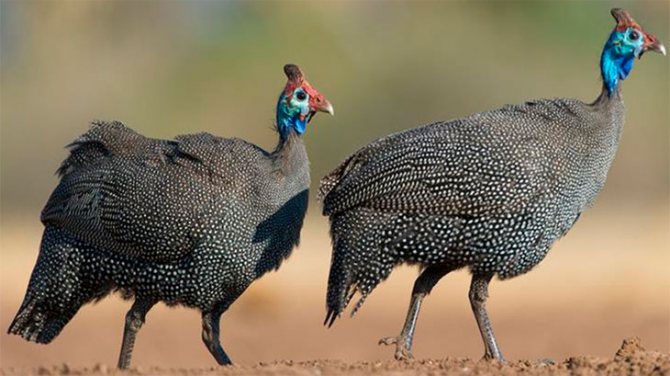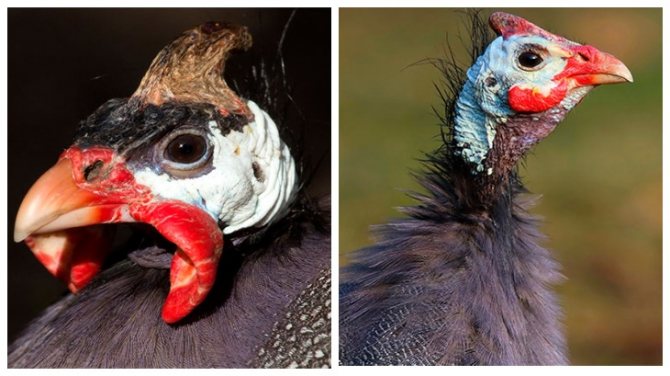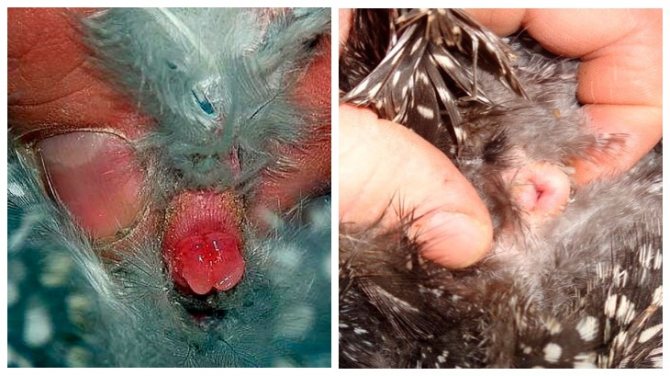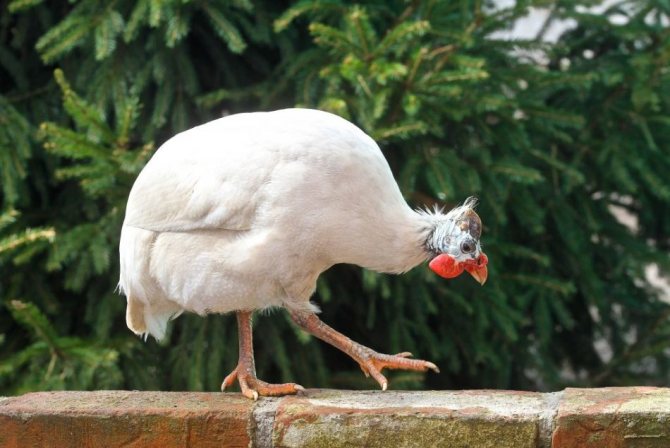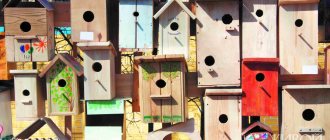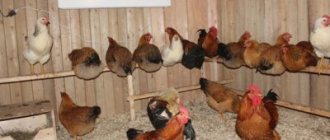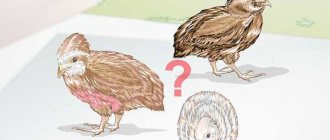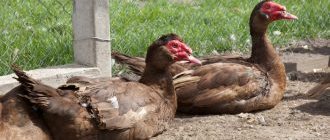Guinea fowls are gaining popularity among owners of subsidiary farms today. Their meat has valuable dietary properties. Guinea fowl eggs are delicious and nutritious. Of course, the conditions of keeping the "royal" bird are significantly different from the conditions of chickens, ducks or geese.
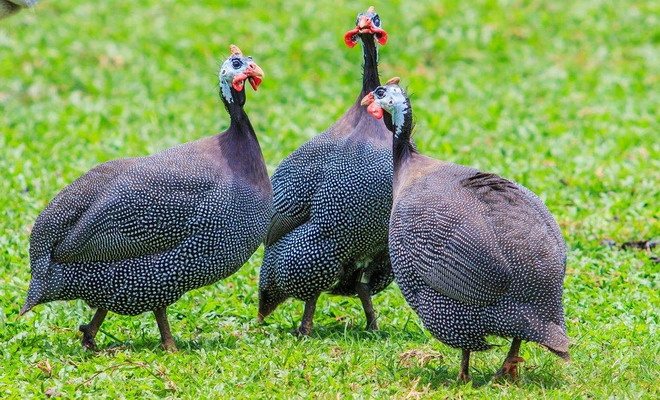
In addition to the feeding, drinking and temperature range, the ability to distinguish male from female will be a very big problem at first. The fact is that at first glance guinea fowls are all alike.
Males, unlike roosters, are neither tall nor comb. Subtle details are not visible to the untrained eye. What are these details, let's try to figure it out.
The easiest way
Even if you do not know the main differences, you can easily distinguish between a male and a female by their size.
So, in order to establish in the herd where the female or the male is who he is and who she is, and how not to confuse them, you can use the simplest sign, namely, they differ in size. Males are not only slightly smaller, but move in a different way. And they behave more mobile.
If there are adults in the livestock, then everything is simple - the largest and most complete are females. Sometimes the difference in some breeds between females and males can be more than 20 percent. However, if you have a large young livestock, in which all of its members look exactly the same, you need to build on other criteria that make it possible to distinguish guinea fowls by sex with one hundred percent certainty and without errors. Let's consider the main ones.
How to distinguish a male from a female guinea fowl by size?
When birds reach the age of 3 months, they show one of the main distinguishing features - body weight. As a rule, the male of any bird weighs much more than the female. This feature applies to many agricultural birds that are bred by humans.
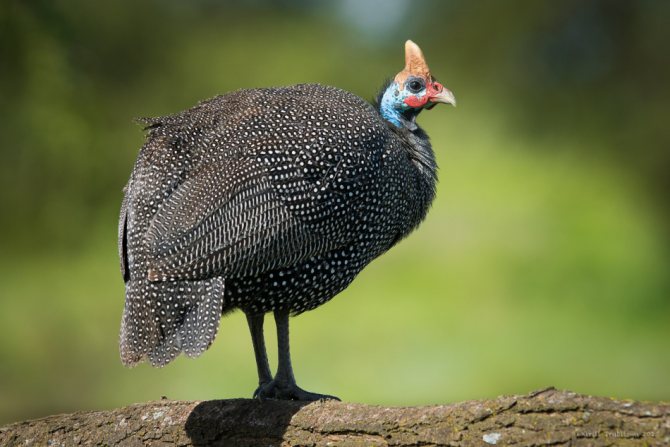

Females are larger
However, this does not apply to guinea fowls. In these birds, the female weighs significantly more than the male. You can notice this if you put the female next to the male. The body of the guinea fowl is much larger than the body of the male.
You can find out exactly the sex by this characteristic if you weigh the birds. The female's weight is sometimes 20% more. But, until a certain age of the birds, you will not be able to use this method, since the guinea fowls often remain approximately the same in size for a long time. You will notice a significant difference when the birds are 5 months old.
Sex differences
Some poultry farmers are sure that until the bird is 3 months old, determining its sex is a futile exercise. However, this is not correct. Those who have been breeding this bird for a long time can accurately determine the sex even in newly hatched chickens. It is not difficult, you just need to carefully examine the external genitalia. This is the surest and most reliable method of determining if all hatched chicks are equal in size and the same color.
In males, the genitals are better developed and similar to a small tubercle. However, when examining it, you need to act slowly and very carefully, since the chicks can get scared and get stress, which will subsequently negatively affect their development.
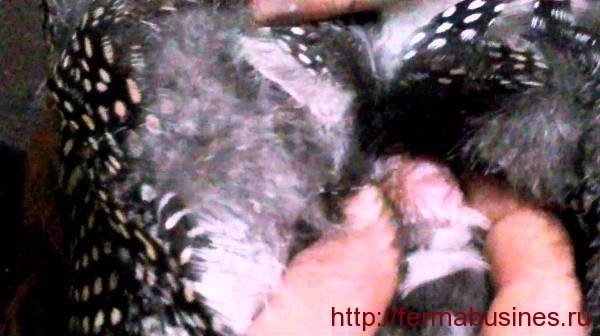

Genitals
When examining, hold the guinea fowl gently in your hands and gently stroke the back. The chick will not only calm down, but this procedure will help to improve blood circulation. This method requires certain skills, but it is not difficult and even a poultry farmer with little experience will quickly master it and subsequently can easily install the floor.
Why is it important to be able to distinguish a female from a male guinea fowl?
How important is it to distinguish between the sex of the guinea fowl? If the breeder is not able to distinguish the sex of the birds, does not know how many guinea fowls and males he has, then he will not be able to control productivity.
So, for example, a small number of eggs does not mean that the birds are sick or live in poor conditions. This is because there are not enough females in the flock. Of course, you can have a lot of birds. However, if there are only 3 guinea fowls among them, do not expect them to produce many eggs. But this is not the most important thing, because of what you have to distinguish between gender.
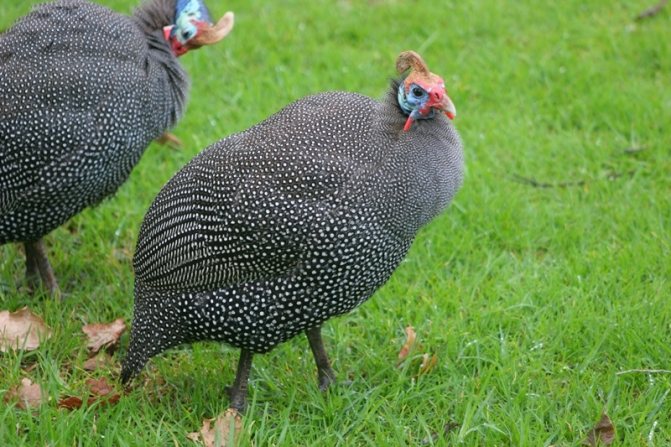

Floor
There are other reasons as well:
- You will be able to track your productivity.
- You will be able to keep track of how many eggs the guinea fowl are laying. If you have extra heads of males or unproductive guinea fowls, you can send them to the slaughter.
- You will increase the number of guinea fowls by breeding them for sale. After all, it is known that guinea fowls begin to rush well if there are 5 guinea fowls for each male.
And most importantly, it is a pleasure to buy the product in which you are completely confident. In the markets, sellers often deceive buyers, and therefore they sell guinea fowls much faster than males. Sellers never think about the field of birds, they are only interested in monetary profit. Therefore, when choosing individuals, choose the chicks yourself.
Sex differences in young animals
It is generally accepted that it is possible to distinguish the sex of guinea fowls only when they reach three months of age, until then there are no differences. Exceptions include certain species of this bird. For example, the Volga cream and white guinea fowls, their plumage is lighter in males.
And nevertheless, sophisticated poultry farmers, who have been breeding a royal bird for more than one year, can distinguish the sex of even day-old chickens. The main features are the external genital organs, since the color of the chicks in both females and males is almost identical.
The differences are as follows:
- in males, the genital organ looks like a small tubercle, which, even at this age, is already well developed;
- in females, any outgrowths are absent.
You need to act according to the following scheme. The chick is very carefully and carefully taken in one and stroked with the other on the back, then the tail moves to the side and the cloaca opens. At the moment, blood is pouring into the tail part, as a result, the tubercle of the penis begins to fill with blood and this makes it stick out a little forward. If you have a female in your hands, the tubercle will not appear.


If there is a tubercle, then a male
At first glance, such a procedure may only seem difficult, in practice it is not difficult to learn it even from the first examination. The main thing is not to scare the guinea fowl, since almost all breeds of this bird are very shy.
In an effort to determine the floor, catch and handle them with extreme care, while the room should be quiet.
Why is it worth checking the sex of guinea fowls
Novice farmers do not always understand why experienced colleagues advise them to learn how to determine the sex of guinea fowls as early as possible. After all, you can determine the sex of a bird when it matures.
We advise you to familiarize yourself with the list of the most popular wild and domestic guinea fowl breeds.
But until this moment, it is necessary to create certain living conditions for it, therefore, in order for the birds to be healthy, and the business is profitable, consider the following:
- the feeding ration should be built depending on the sex of the guinea fowl. Layers need more vitamins and minerals for the egg-laying period;
- during the period of laying eggs, males must be removed from females, since the caesars become aggressive;
- if you keep the guinea fowl just for the eggs, then one male is enough for several females. And if you are not chasing offspring, then the number of tsars can be minimized.
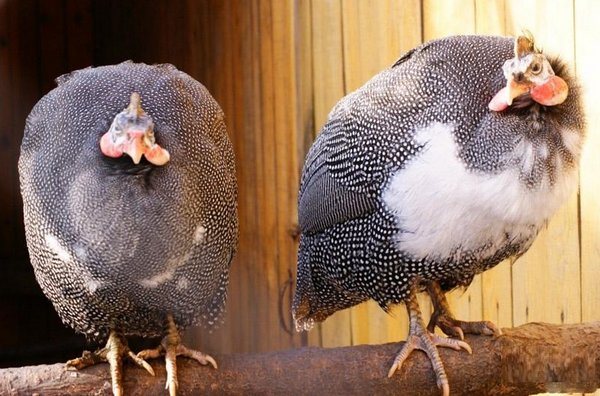

By correctly distributing the number of birds, you will greatly facilitate caring for it, and increase productivity.
More differences
It is not difficult to distinguish a male from a female guinea fowl, the main thing is to know the main features, which include the structure of their head, appearance, demeanor, as well as voice. If we talk about adult birds, then in males:
- the beak is much larger than that of females;
- earrings are thicker and fleshy;
- there is a beard;
- the scallop on the head is slightly larger and bent back;
- during movement, the head is slightly tilted forward, which they try to raise higher, showing others their own superiority;
- the tail is bent towards the top;
- the males scream intermittently, with a specific crackle.
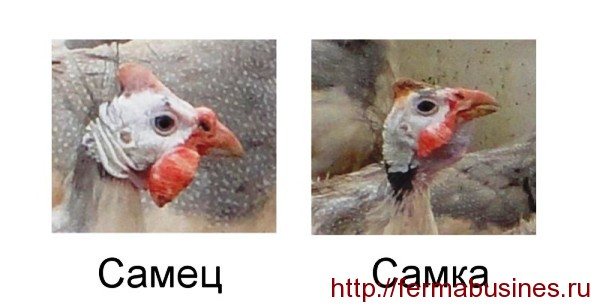

Additional differences
the signs of females are as follows:
- big sizes;
- timid gait, head and tail are lowered;
- head and beak are small;
- the beard is missing;
- small earrings;
- the scallop is small and upright;
- her voice is comparatively quiet, without crackling, a little like "y-a", very different from the voice of males.
Bird breeding
For good egg production, a spacious aviary should be built for the guinea fowls. It will need to be fenced off with a two-meter fence, in the event that the wings have not been clipped to the individuals. You can plant several bushes in the enclosure to simulate natural walking. Fertilized eggs are needed to breed offspring. One male will be enough for a family of 5-6 females. These birds may well hatch eggs and take care of chickens, but due to their fearfulness, there is a high probability of leaving the clutch unattended.
Chickens and turkeys are used as hens - the egg is placed under the female. For hatching chicks, you can use an incubator just like for normal chicks. But the humidity level in it should be slightly higher. Individuals rush every 3-4 days. Eggs not older than 5 days are placed in the incubator. Before laying, eggs should be lightly bumped against each other. In this case, a rattling sound can be heard, such eggs have microcracks and are not suitable for hatching.
Incubator hatching
For two weeks, the temperature in the incubator should be kept within 37.8 degrees. In the last days of hatching, the temperature must be reduced to 37.5 degrees. The egg is placed in a horizontal position with the sharp tip down. Within 24 days, eggs should be turned up to 6 times a day, otherwise the embryo may stick to the shell wall. To simplify the identification of the sides, markers can be placed on the shell. After 27 days, the first chicks appear.
What you need to buy for budgies
Having mastered how you can distinguish a male budgie from a female, and having decided on the choice of bird, you will need to provide the future pet with a suitable place to stay in your house. First of all, you should purchase a cage. A budgerigar house should be simple and fairly spacious. For two parrots, a triangular or square cage 60x40 cm is best suited.
When choosing a suitable bird dwelling, take a closer look at the side walls. If you do not have the desire and ability to clean up fluff, husks and feathers throughout the room every day, it is better to take a cage with high walls. It is desirable that they are transparent, allowing you to observe the bird and keep the area clean.
Having chosen the most suitable house for your future pet, do not forget to also purchase a drinker, food, mirrors, toys, etc.Currently, there are many accessories on sale that can brighten up the leisure of your feathered friend during your absence.
The budgie needs to be loved and pampered, with warm care and patience. And then he will delight you with his cheerful mood.
Guinea fowls are quite rare in the domestic economy. For this reason, poultry farmers often face difficult challenges in breeding these birds. And among them the question of the sex of the royal chickens should be highlighted. How to tell males from females? This is what will be discussed in the review.
There are many Guinea Fowls in your farm, but how to determine the sex is unknown? As the photos show, males and females have a similar appearance. Therefore, it is rather difficult to distinguish them at one day of age. In order not to suffer over this issue, you should just carefully examine the Guinea fowl. The difference between a female and a male can still be found.
The video will talk in sufficient detail about what the royal birds are.
Weight indicators
A bird that is large in comparison with others is a female. Naturally, Guinea fowls differ in large dimensions from other species of birds. But this feature will quickly become familiar. It should be noted that females weigh about 20% more than males.
What if the size of the Guinea Fowl cannot be distinguished by sex? In this situation, you should not panic, since everything is quite simple. Birds, regardless of gender, have unique characteristics. Knowing these characteristics will help identify the male and female.
Beak shape and scallop position
Novice poultry farmers determine sex based on one criterion: if a bird produces eggs, then it is a female. However, in the event that you want to provide the required care, gender determination is a necessary task. And the most obvious difference lies in the structure of the head.
Take a closer look at the beak of the Guinea Fowl. As numerous photos show, in females it is small and neat. The Caesars have it fat. In addition, their beak is decorated with a growth, which can be noticed immediately.
You should look closely at the comb to distinguish the Caesar from the girl. In the male, the comb is in a slightly raised position, curving back. For this reason, it looks large enough. Pay attention to the position in which the head is. Females try to keep it level, unlike males.
Earrings
Guinea fowls have earrings under their beaks. They are considered the main decoration of the royal bird. However, they acquire the greatest value when it is required to determine the gender. In the Caesars, they are thicker, fleshy. They are easy to spot. The female part of chickens is distinguished by neat and delicate earrings.
However, according to this parameter, sex can only be distinguished in young individuals. In older hens, the earrings become coarser.
Sound of a voice
Guinea fowls are quite loud birds. This is their main disadvantage. However, their "sociability" can be used to try to distinguish between a male and a female. In the male half, the sound of the voice is specific.
The sounds of males are abrupt, a kind of crackling prevails in them, which is not in the voice of females. Laying hens emit slightly different signals, reminiscent of the "Whoa" sound.
Royal behavior
Take a closer look at the behavior of the royal birds. Females are more modest. They lower their head and tail while walking. The Caesars are trying to demonstrate their pride and superiority. Therefore, their head and tail are always in a raised state, which is demonstrated by numerous photos.
Sexual characteristics
There are poultry farmers who argue that it is impossible to determine sex until the bird is 3 months old. However, this is a delusion.Experienced breeders who have studied the royal birds in sufficient detail will be able to easily distinguish them by their external sex.
In males, the genital organ is well developed. It takes the form of a small tubercle. To see it, you need to show a little caution and accuracy, since birds are timid, easily entering a stressful state.
It is necessary to take the chick, move the tail and open the cloaca. In the male, a slightly protruding tubercle can be seen. The female will not be able to see anything. Do not forget to periodically stroke the back of the bird while performing the sex determination procedure. This will help her feel safe. In addition, through these simple steps, you can stimulate blood flow.
Naturally, such a technique for identifying the sex of the Guinea Fowl should be resorted to only when there is special knowledge and skills. However, with a little practice, you can accurately distinguish between a cock and a hen with a little time. You have all the necessary knowledge for this.
Breeding birds at normal home conditions
There is a certain number of species of guinea fowl, although only gray has taken root on the farm. And all breeding farms or just bird lovers grow this particular breed.
For productive feeding of guinea fowls at home, you need to purchase thoroughbred birds.
Siberian snow-white and overseas white-breasted guinea fowls are in demand in home breeding. At three months, young animals usually gain 1.3 kg of weight. Adult birds gain up to 2 kg of weight, and the female is often heavier than the male.
Breeding guinea fowls at home for beginners is available for many reasons:
- no heated building will be needed to keep the flock. Birds are ready to withstand cold to minus fifty-five degrees, although extreme conditions should not be done;
- birds perfectly understand their own flock, adhere in groups. They distinguish the owner and are not at all shy about him. When a third party appears in the field of view, they scream, thereby the watchman of the courtyard;
- guinea fowls can be released into the garden, they do not rake the territory, do not peck foliage, look for bugs and worms on the soil surface;
- they have inexpensive feeding, since half of the norm per day is greens and boiled fruits;
- keeping in rooms without heating with dry bedding and perches.
Distinctive features
If at least 5-10 guinea fowls are present in the courtyard, how do you know where is the male and where is the female? The complexity is present, since they are almost all similar to each other. In order not to spend too much time on this, you will have to look closely at each individual and there will be differences. Firstly, it is the size, if one of the birds exceeds the other by two kilograms - the male. In this they differ significantly from other animals, but, in the herd, it is gradually easy to get used to this pattern.
Read also: Arugula: benefits and harms, vitamins and minerals, use in cooking
The question remains relevant, how to distinguish birds if they are all the same. You should not panic, since the bird has differences, these are specific manifestations, knowing about which everything will become easy.
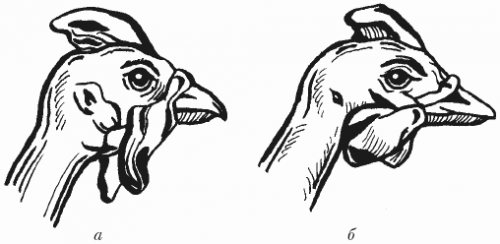

The difference in sex of guinea fowls: a) - the head of the male, b) - the head of the female
How to distinguish between birds by beak and head
The beak and head have the most obvious distinctive features in individuals of different sexes. Let's list them.
- The size. Females have much smaller beaks than males, and their beak looks much neater.
- Goatee. There is always a “beard” on the beak of a male - a specific growth that immediately catches the eye if you look closely. Females do not have such a growth.
- All individuals have a comb on the head, but in males it looks a little larger, since it bends back. The comb of the hens sticks out strictly vertically.
- Position.Even by exactly how these birds hold their heads, you can tell whether the caesar is in front of you or the guinea fowl. Females always keep their head and neck upright, even. Males, on the other hand, move their heads slightly forward all the time.
- Earrings. This is one of the most visible ornaments on the heads of royal birds. They are located under the beak, and by their size you can also easily distinguish males from females. In the Caesars, the earrings are pronounced, they are both thicker and fleshy than their friends. Guinea fowls also have earrings, but their appearance is more accurate and delicate. However, the older the female becomes, the more bulky her earrings become, starting to approach in size to the jewelry more characteristic of males.
Description and general characteristics
The homeland of birds is the island of Madagascar and the western regions of Africa. Of all the species existing in nature, only one has become domestic - the gray guinea fowl. They have a beautiful uniform color, large eyes, a red beard and a projection on the top of the head. They are bred for more than just tender, flavorful meats and nutritious eggs. Guinea fowls are able to protect farms from predators by acting as a natural signaling device. Birds are also known as greedy insect eaters and are a boon in any garden with pest problems. They are the only ones who eat Colorado beetles.

